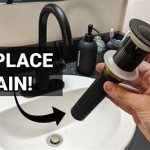How To Remove Salt Water Stains From Bathroom Tiles
Saltwater intrusion and the subsequent stains it leaves behind pose a significant challenge for homeowners, particularly those residing in coastal regions. The presence of salt water, even in seemingly small quantities, can lead to the gradual degradation of bathroom tiles, leaving unsightly stains and potentially damaging the underlying structure. Understanding the mechanisms behind these stains and implementing appropriate removal techniques are essential for maintaining the aesthetic appeal and structural integrity of bathrooms.
The formation of saltwater stains on bathroom tiles is a complex process, involving the interaction of saltwater, the tile material, and environmental factors. Saltwater, primarily composed of sodium chloride, contains other minerals and organic matter. When saltwater comes into contact with bathroom tiles, the water evaporates, leaving behind a residue of dissolved solids. These solids crystallize on the surface of the tile, forming a visible stain. The appearance and severity of the stain depend on factors such as the concentration of salt in the water, the porosity of the tile, and the frequency of exposure. Porous tiles, such as natural stone or unglazed ceramic, are more susceptible to staining than non-porous tiles like porcelain or glass.
The presence of saltwater stains not only detracts from the appearance of the bathroom but can also lead to long-term damage. The salt crystals can penetrate the tile surface, causing it to become brittle and prone to cracking. This is particularly problematic in areas subject to temperature fluctuations, as the expansion and contraction of the salt crystals can exacerbate the damage. Furthermore, the accumulation of salt can create a favorable environment for the growth of mold and mildew, further compromising the hygiene and air quality of the bathroom.
Prevention is often the most effective strategy for managing saltwater stains. Minimizing exposure to saltwater through regular cleaning and maintenance can significantly reduce the likelihood of staining. Ensuring proper ventilation in the bathroom can also help to reduce humidity levels, limiting the evaporation of saltwater and the subsequent deposition of salt crystals. However, even with diligent preventative measures, saltwater stains may still occur. Therefore, it is crucial to have a range of effective removal techniques at one’s disposal.
Identifying the Type of Tile and Stain Severity
Before attempting to remove saltwater stains, accurately identify the type of tile and the stain’s severity. Different tile materials react differently to cleaning agents. Using an inappropriate cleaner can damage the tile or worsen the stain. Common bathroom tile materials include ceramic, porcelain, natural stone (such as marble, granite, and limestone), and glass. Ceramic and porcelain tiles are generally durable and resistant to staining, while natural stone tiles are more porous and susceptible to damage from acidic or abrasive cleaners.
The severity of the stain also influences the choice of cleaning method. Mild stains, characterized by a light residue or discoloration, can often be removed with gentle cleaning solutions and minimal scrubbing. More severe stains, which may involve deeply embedded salt crystals or discoloration, may require stronger cleaning agents and more aggressive scrubbing techniques. In extreme cases, professional tile cleaning or restoration services may be necessary.
A simple test to determine the tile's porosity involves placing a few drops of water on the surface. If the water beads up, the tile is likely non-porous. If the water is absorbed quickly, the tile is likely porous. This test can help guide the selection of appropriate cleaning products and techniques.
Effective Cleaning Solutions and Methods
A variety of cleaning solutions and methods can be employed to remove saltwater stains from bathroom tiles. The choice of method depends on the type of tile, the severity of the stain, and personal preferences. It is always advisable to test any cleaning solution in an inconspicuous area before applying it to the entire surface to ensure that it does not damage or discolor the tile.
1. Warm Water and Mild Detergent: This is the gentlest and often the most effective method for removing mild saltwater stains from most types of tiles. Mix a small amount of mild dish soap or detergent with warm water. Apply the solution to the affected area and scrub gently with a soft cloth or sponge. Rinse thoroughly with clean water and dry the tile with a clean towel.
2. Vinegar Solution: Vinegar, a mild acid, can be effective in dissolving salt deposits. Mix equal parts white vinegar and water. Apply the solution to the stained area and allow it to sit for a few minutes. Scrub gently with a soft brush or sponge. Rinse thoroughly with clean water and dry the tile. Note that vinegar can etch or damage some natural stone tiles, such as marble and limestone. Therefore, it is crucial to test the solution in an inconspicuous area before applying it to the entire surface. For natural stone, consider using pH-neutral cleaners designed specifically for these materials.
3. Baking Soda Paste: Baking soda is a mild abrasive that can help to remove stubborn stains. Mix baking soda with water to form a paste. Apply the paste to the stained area and let it sit for a few minutes. Scrub gently with a soft brush or sponge. Rinse thoroughly with clean water and dry the tile. Baking soda is generally safe for most types of tiles, but it is still advisable to test it in an inconspicuous area first.
4. Commercial Tile Cleaners: Numerous commercial tile cleaners are available, specifically formulated for removing various types of stains, including saltwater stains. When selecting a commercial cleaner, carefully read the product label and ensure that it is appropriate for the type of tile. Follow the manufacturer's instructions carefully, and always test the cleaner in an inconspicuous area before applying it to the entire surface. Be aware that some commercial cleaners contain harsh chemicals that can damage tiles or pose health risks. Always wear appropriate protective gear, such as gloves and eye protection, when using these products.
5. Steam Cleaning: Steam cleaning can be an effective way to remove saltwater stains, especially from grout lines. The high temperature of the steam helps to dissolve salt deposits and loosen dirt and grime. When using a steam cleaner, follow the manufacturer's instructions carefully. Ensure proper ventilation in the bathroom to prevent moisture buildup. Be cautious when using steam cleaners on porous tiles, as the moisture can penetrate the tile and potentially cause damage.
Addressing Grout and Preventing Future Stains
Grout lines are particularly susceptible to saltwater staining due to their porous nature. The porous nature makes them readily absorb saltwater, leading to discoloration and the growth of mold and mildew. Cleaning grout lines effectively requires specific techniques and cleaning agents.
1. Grout Cleaning Solutions: Numerous grout cleaning solutions are available, specifically formulated to penetrate and dissolve embedded dirt and grime. When selecting a grout cleaner, choose one that is appropriate for the type of grout. Some grout cleaners contain bleaching agents, which can effectively remove stains but may also discolor colored grout. Always test the cleaner in an inconspicuous area before applying it to the entire surface.
2. Grout Brush: A stiff-bristled grout brush is essential for effectively scrubbing grout lines. Apply the grout cleaning solution to the grout lines and allow it to sit for a few minutes. Scrub the grout lines vigorously with the grout brush. Rinse thoroughly with clean water and dry the grout. For heavily stained grout, you may need to repeat the process several times.
3. Baking Soda and Vinegar Paste: A paste made from baking soda and vinegar can also be effective for cleaning grout lines. Mix baking soda and vinegar to form a paste. Apply the paste to the grout lines and let it sit for a few minutes. Scrub the grout lines with a grout brush. Rinse thoroughly with clean water and dry the grout. This mixture can cause a fizzing reaction, which helps to loosen dirt and grime.
4. Grout Sealing: Sealing grout lines is an effective way to prevent future saltwater staining. Grout sealers create a barrier that prevents saltwater from penetrating the grout. Apply a grout sealer to clean, dry grout lines. Follow the manufacturer's instructions carefully. Reapply the sealer periodically, as needed, to maintain its effectiveness.
5. Addressing the Source: Beyond cleaning, identifying and addressing the source of the saltwater intrusion is crucial for long-term prevention. This may involve repairing leaky pipes, improving drainage around the building, or implementing measures to prevent saltwater from entering the bathroom. Ignoring the source of the problem will result in recurring stains and potential damage.
Preventing future saltwater stains requires a multi-faceted approach, including regular cleaning, proper ventilation, and addressing the source of the saltwater intrusion. Regular cleaning with mild detergent and water can help to remove salt deposits before they become deeply embedded. Ensuring proper ventilation in the bathroom can help to reduce humidity levels, limiting the evaporation of saltwater and the subsequent deposition of salt crystals. Addressing the root cause of the saltwater intrusion is essential for preventing recurring stains and potential damage to the bathroom tiles and grout.

How To Remove Salt Water Stain From The Bathroom Tiles Turlock Ca

3 Best Ways To Get Rid Of Hard Water Stains From Bathroom Tiles Kent

How To Clean Or Remove Salt Water Stains On Sink Tap Floor Tiles Hard

How To Remove Stains From Bathroom Tiles

How To Remove Hard Water Stain From Tile And Grout

How To Clean Bathroom Tiles From Saltwater And Soap Stains At Home

3 Best Ways To Get Rid Of Hard Water Stains From Bathroom Tiles Kent

2 Ways To Remove Hard Water Stains From Tiles

How To Remove Hard Water Stains From Tile And Grout Woodard

3 Best Ways To Get Rid Of Hard Water Stains From Bathroom Tiles Kent
Related Posts







